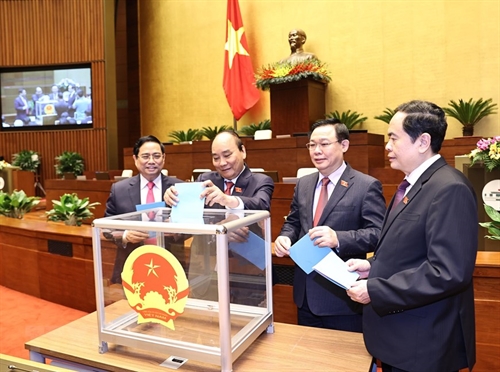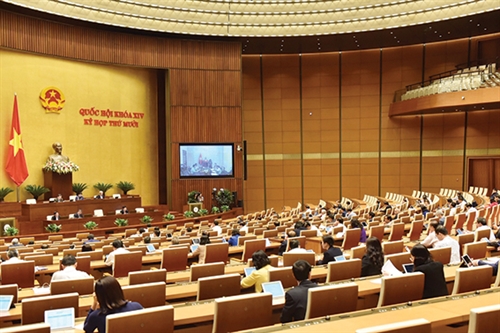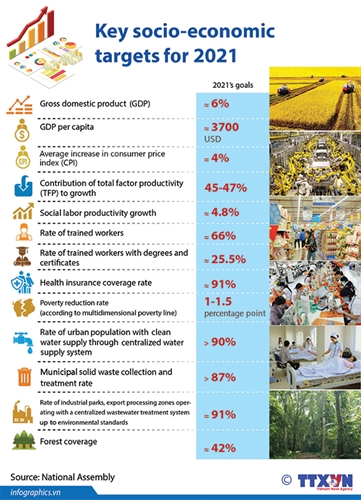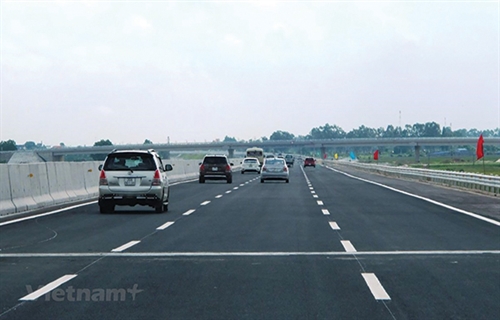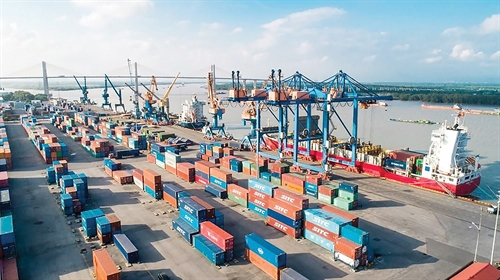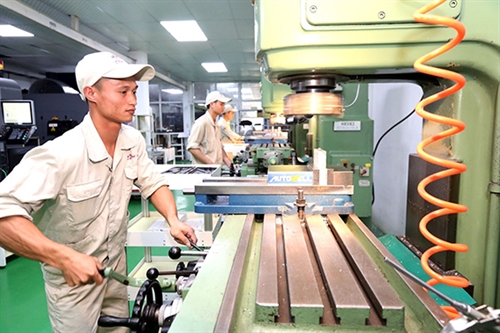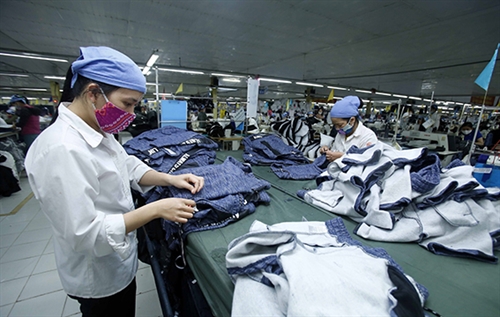The 2020 Law on Environmental Protection (the Law), effective from 2022, introduces numerous breakthrough policies concerning environmental criteria-based classification of investment projects, environmental licenses, circular economy, response to climate change, responsibility for environmental incident prevention and response, application of best available techniques, environmental audit, and mechanisms to enhance environmental protection law compliance. This article highlights the above policies as part of the State’s environmental protection efforts.
Nguyen Thi
Ministry of Natural Resources and Environment
Environmental criteria-based classification of investment projects
Under the current environmental protection law, this content is used as a basis for identifying objects in need of to environmental impact assessment. According to the Law, the environmental criteria-based classification of investment projects is provided in a scientific manner in Article 28 under which investment projects are divided into four groups. Group I includes projects highly likely to exert adverse environmental impacts; group II covers projects likely to exert adverse environmental impacts; group III embraces projects unlikely to exert adverse environmental impacts; and group-IV projects are those highly unlikely to exert adverse environmental impacts. The classification criteria include: (i) scale, capacity, and type of production, business or service provision; (ii) areas of land, land with water surface and marine zones in use, scale of exploitation of natural resources; and (iii) environmentally sensitive factors.
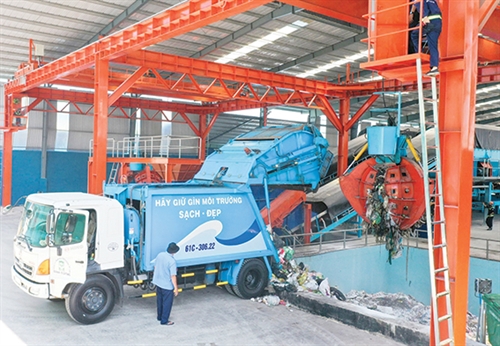 |
| Garbage is transported to South Binh Duong waste treatment plant in Binh Duong province for treatment__Photo: Chi Tuong/VNA |
The Law sets appropriate provisions for each group of investment projects on the principle that the more polluting a project is, the more strictly it will be controlled. Specifically, for group-I projects, the Law provides more management measures, such as preliminary environmental impact assessment (Article 29) in the stage of construction investment prefeasibility study, investment policy proposal, request for investment policy approval, or investment policy approval; environmental impact assessment (Article 30) in the process of feasibility study; and environmental licenses (Article 39) required for projects discharging wastewater, dust or emissions subject to treatment or discharging hazardous wastes subject to management before operation.
Group-II projects are not subject to preliminary environmental impact assessment while environmental impact assessment is required only for some types of projects. For other projects that discharge wastewater, dust or emissions subject to treatment or discharge hazardous wastes subject to management, environmental licenses will be granted right in the stage of feasibility study.
Group-III projects are not subject to both preliminary environmental impact assessment and environmental impact assessment. If discharging wastewater, dust or emissions, these projects must seek environmental licenses from local competent authorities.
Environmental registration is required for group-IV projects that discharge wastes (Article 49), with commune-level People’s Committees assigned to receive environmental registration dossiers for these projects.
As provided in the Law, an environmental license integrates the contents of all existing environmental permits and certificates regarding discharge of wastewater, discharge of emissions, treatment of hazardous wastes, import of scraps, and registration of hazardous waste generators. This change will help reduce licenses and licensing procedures as well as costs for investors while ensuring the unified state management of the environment.
The above classification of investment projects is expected to facilitate the application of suitable environmental management tools to different types of projects in each stage of project implementation. This approach has been effectively applied by different countries around the world.
Regarding load capacity of the environment, the Law states that an environmental license will be granted based on zoning of environmental areas and load capacity of the environment (Article 42). According to Article 7.2, it is not permitted to approve results of appraisal of environmental impact assessment reports or grant environmental licenses for new investment projects that discharge wastewater into surface water sources when these sources can no longer store wastewater as announced by a competent state agency. To get such permission, owners of these projects must have plans on treatment of wastewater up to environmental technical regulations on quality of surface water before discharging wastewater into the receiving waters or plans on cycling and reuse of wastewater to prevent generation of more wastewater, or such projects are those engaged in pollution treatment, remediation, rehabilitation or quality improvement of the environment in polluted areas. Strict implementation of these new regulations will help reduce severe pollution or environmental degradation, thus effectively guaranteeing the people’s right to live in a clean environment.
Circular economy and management of solid wastes
Circular economy is a completely new conception introduced in the Law to embrace the current development trend in the context that natural resources, fuel and materials have become scarce. The transformation of a linear economy, in which natural resources and input materials undergo the process of production, consumption and discharge, into a circular one in which designing, production, consumption and service activities aim to reduce the exploitation of materials, extend the lifespan of products, and reduce wastes and adverse environmental impacts (Article 142) underlines that natural resources may be conserved and circulated through innovating designs, applying advanced production technologies and using recycled materials.
The Law also sets a new management regime for solid wastes in order to gradually form a circular economy, including application of extended producer responsibility (EPR) policy approach to the recovery and recycling of products and packaging (Article 54); payment for service charges for collection, transportation and treatment of domestic solid wastes based on the volume of sorted wastes (Article 79); and self-recycling, treatment, co-treatment of, or recovery of energy from, normal industrial solid wastes (Article 82).
The provisions of Article 54 on responsibility of producers and importers to recycle products and packaging serve as critical grounds for full application of EPR policy approach under which entities that produce and import recyclable products and packaging must recycle such products and packaging according to compulsory ratios and specifications. These entities may organize by themselves the recycling or make financial contributions to the Vietnam Environment Protection Fund to support the recycling.
Regarding payment of charges for collection, transportation and treatment of domestic solid wastes based on the volume of sorted wastes, the Law requires that domestic solid wastes must be sorted into reusable or recyclable solid wastes, food wastes, and other solid domestic wastes. Such solid wastes must be put in separate packages for collection and treatment. Places for collection and transit of solid wastes must have different areas for separate storage of sorted solid wastes. Reusable or recyclable solid wastes and properly sorted hazardous wastes are not liable to charges for collection, transportation and treatment. Other types of solid wastes must be stored in packages provided by local People’s Committees to facilitate their collection and recycling. Garbage-collecting and -transporting units may refuse to collect and transport wastes that are neither sorted nor put in proper packages.
So, the Law has clear provisions allowing local administrations to collect money to pay for the treatment of domestic solid wastes through selling plastic bags at affordable prices; waste-collecting units will only collect wastes contained in such bags. If not wishing to buy many plastic bags, the people should reduce garbage, sort out garbage (putting recyclable garbage in separate bags for sale or transfer without having to pay collection charges), and use less plastic bags.
The Law’s provisions on self-recycling, treatment, co-treatment of, or recovery of energy from, normal industrial solid wastes aim to facilitate the recycling, reuse of, and recovery of energy from wastes, manufacture of building materials, and ground filling, thus basically dealing with normal industrial solid wastes currently piled up and discarded.
Creating a legal framework for promoting climate change response activities and fulfilling international commitments
The Law’s provisions on adaptation to climate change (Article 90) cover various issues. They include evaluation of risks, losses and damage caused by climate change; activities to adapt to climate change and mitigate disaster risks and build community- and ecosystem-based climate change adaptation models; response to sea level rise and urban inundation; and building and operation of systems for monitoring and evaluation of climate change adaptation activities. Meanwhile, Article 91 regulates the reduction of greenhouse gas emission, such as implementation of roadmaps and modes for greenhouse gas reduction under international commitments of Vietnam; inventory of greenhouse gas, and development of the domestic carbon market.
The organization and development of the carbon market are touched upon in Article 139. This is a new market instrument which can, on the one hand, help fulfill international commitments on reduction of greenhouse gas emission and, on the other hand, assist local businesses in developing and applying low-carbon technologies. Importantly, this serves as a basis for development of the domestic carbon market in association with the international carbon market with a view to increasing the exchange of greenhouse gas emission quotas and carbon credits in conformity with Vietnam’s law and treaties to which Vietnam is a contracting party.
The provisions of Article 92 on protection of the ozone layer will help manage the production, import, export, consumption and exclusion of controlled ozone-depleting substances and substances causing the greenhouse effect within the framework of the treaty on the protection of the ozone layer. Other provisions of Articles 96, 97 and 98 aim to expand the scope of climate change response activities, such as inclusion of climate change response contents in relevant strategies and master plans; development of the national database on climate change; and fulfillment of international commitments on climate change and protection of the ozone layer.
Responsibility for environmental incident prevention and response
Environmental incident prevention and response are provided in Articles 121 thru 129, which clearly define the competence, responsibilities and mechanisms for prevention, response preparation, and response to environmental incidents, and post-incident environmental rehabilitation on the basis of flexibly applying incident/disaster response and search and rescue mechanisms. These provisions aim to prevent environmental incidents caused by production, business and service establishments and, at the same time, serves as grounds for formulation of plans on environmental incident response. Plans of this kind should be incorporated in and approved together with plans on response to other incidents so as not to give rise to administrative procedures.
Response to environmental incidents will be carried out corresponding to four levels of incidents, namely grassroots-, district-, provincial- and national-level environmental incidents. Under the Law, chairpersons of district- or provincial-level People’s Committees or the Chairperson of the National Committee for Incident and Disaster Response and Search and Rescue will direct the incident response through setting up commanding offices for environmental incident response and working groups to identify causes of incidents; designating commanders and spokespersons for environmental incidents; and mobilizing forces for the incident response.
Post-incident environmental rehabilitation will be carried out under environmental rehabilitation plans approved by district- or provincial-level People’s Committees or the Ministry of Natural Resources and Environment, depending on the level of incident, in conformity with technical regulations on quality of the surrounding environment. If incident causers are not yet identified, the agencies having approved environmental rehabilitation plans will organize the implementation of these plans.
Incident causers have to promptly and fully pay expenses for incident response and environmental rehabilitation. In case incident response and environmental rehabilitation activities are carried out by state agencies, incident causers will have to refund relevant expenses to the State. For incidents with unidentifiable causes and causers, expenses for incident response and environmental rehabilitation will be borne by the State.
Application of state-of-the-art techniques and environmental audit in environmental control
The provisions on application of best available techniques (BATs) under Article 105 focus on the technology-based management method, thus helping raise production efficiency, conserve energy, and increase proactivity in pollution prevention and control based on the application of BATs as suitable to the economic situation and investment capacity. Meanwhile, Article 74 states that environmental audit serves as an instrument helping investors identify changes in input factors of the production process so as to work out measures to raise production efficiency and treat wastes, i.e., periodical proactive evaluation. On that basis, managers and investors will be more active in controlling environmental issues and identifying levels of pollution caused by production facilities before taking intervention measures or claiming compensation.
Compliance with environmental protection law
Given that Vietnam still witnesses low-level compliance with environmental protection regulations while new-generation free trade agreements (like the Comprehensive and Progressive Agreement for Trans-Pacific Partnership and European-Vietnam Free Trade Agreement) set higher requirements on compliance with the environmental law, the Law makes numerous provisions to ensure feasibility of key environmental protection regulations. Specifically, concerning the state management of the environment, the Law assigns the Ministry of Natural Resources and Environment to manage the environment and granting environmental licenses, including wastewater discharge licenses. Meanwhile, the system of state management agencies in charge of environmental protection will be further streamlined to ensure more effective enforcement of the environmental protection law.
Mobilization of social resources for environmental protection activities is the greatest breakthrough in the Law under the motto that environmental protection is not only the responsibility but also the right of individuals, organizations, communities and state agencies. The State will now act as an agency issuing, and organizing the implementation of, policies and laws and as an arbitrator in handling violations. Resident communities will be assigned with environmental protection self-management tasks, such as supervising the sorting and discharge of domestic garbage and overseeing environmental protection activities of projects and production, business and service establishments. The Ministry of Natural Resources and Environment will create mechanisms for receiving and handling reports and petitions about polluting acts in particular and violations of the environmental protection law in general. The most important mechanisms for mobilization of social resources for environmental protection activities include those on payment for domestic solid waste collection and treatment services based on waste volume; extended producer responsibility for used products and packaging; payment of deposits for environmental protection; payment for environmental incident responses and post-incident environmental rehabilitation; compensation for environmental damage; insurance for liability to pay compensation for environmental incidents; and payment for natural ecosystem services.
Conclusion
The 2020 Law has the most fundamental, substantial and practical provisions which basically meet the requirements and expectations on environmental protection and sustainable conservation of natural resources in the coming time and catch up with environmental protection and sustainable development trends of other countries in the world and conform to Vietnam-made international commitments. The enforcement of these provisions would require great efforts and support from the people, communities and administrations at all levels in order to protect and improve the environment and ensure the harmonious co-existence between humans and the nature.-
